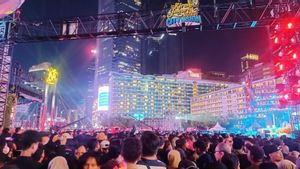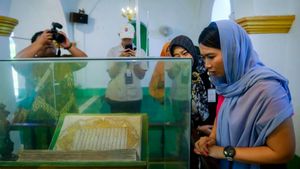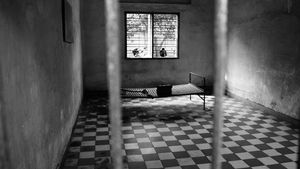JAKARTA - Talking about Menteng, it is a bit difficult if you don't discuss at length about a shady park full of trees known as Taman Suropati. Jakartans not only make this beautiful park a place of solace, escape from the congestion and noise typical of the capital, but also as a place where creative ideas can be generated.
Taman Suropati, which is located on the north side of Jalan Diponegoro, Central Jakarta, is definitely not just any park. Through his name alone, all Indonesians who know the gutsy spirit of a national hero named Untung Suropati will certainly voice their admiration for this park which was originally shaped like a hill.
Moreover, Untung Suropati is not an arbitrary figure. Because of his fame, Iksaka Banu through his short story, Penunjuk Jalan (2007), revealed the figure of a national hero from Bali as a person who is feared by the Dutch government. "He is a leader of thieves. Dutch haters. Killed lots of soldiers since escaping stadhuis. The number one fugitive of the Company. "
The admiration for Taman Suropati will increase if you know that the center of Menteng City was once a Round Square - the forerunner of Taman Suropati - which was the meeting point of the main roads, namely Menteng Boulevard (Jalan Teuku Umar), Orange Boulevard (Jalan Diponegoro) ), and Nassau Boulevard (Jalan Imam Bonjol).
That's thanks to the services of the architect PAJ Moojen in 1912 who made the Round Field. Unfortunately, because the Round Square was too wide and had the potential to obstruct the smooth flow of traffic, along with this problem, Moojen's plan was changed.
Then, right in 1918, the City of Batavia government began to appoint a new architect FJ Kubatz and FJL Ghijsels to perfect it. At the same time, the plan to build Taman Suropati began. Zaenuddin HM, in his book, Origins of Djakarta Tempo Doeloe (2018) explains, over time, the Round Square then began to be trimmed and part of the land was dumped into Jalan Besuki.
In fact, the city government of Batavia at that time had started planting trees and flowers since 1920. "The field which is now known as Taman Suropati since 1920 has replaced the large Round Square in Moojen's plan," wrote Zaenuddin HM.
Regarding Taman Suropati which is included in the refinement of Moojen's plan, Adolf Heuken and Grace Pamungkas in the book Menteng: Kota Taman Pertama in Indonesia (2001) also reveal Suropati Park as the center of Menteng which is known as the meeting place for the east-west and north-south axis of Jakarta.
Presumably, that is what makes a park that combines square and circle shapes with various supporting facilities, making it one of the best quality parks in the city of Jakarta. This is because, among the ornaments that fill the garden that was once named Burgemeester Bisschopplein, there are many sculptures by talented artists from all over ASEAN.
Burgemeester Bisschopplein
On its way, Taman Suropati was named Burgemeester Bisschopplein in the Dutch East Indies era. The name was deliberately given by the Company as a tribute to the person who held the position of Burgermeester or the first Mayor of Batavia in 1916, Mr. GJ Bisschop.
His work as Mayor who led Batavia from 1916 to 1920 deserves thumbs up. Quoted from Zeffri Alkatiri, author of the book Jakarta Punya Cara (2012), Mr. Bisschop at that time had pioneered many developments, especially service facilities for the people of Batavia City.
Most of them Mr. Bisschop adopts the methods used by the city government in the Netherlands. Because, before visiting Batavia, he had held an important position for several years as a bureaucrat at the Hollandsche Gemeenteadmnistratie, a Dutch Administration Ministry.
During his tenure as Mayor, achievements have been made by Mr. Bisschop. Zeffry also said, “... in his time, he had moved the construction of a piped water installation from Ciomas-Bogor to Batavia (1918–1920). Previously, he had also increased the need for clean water by building more than ten wells and pumps in various areas in Batavia. "
"He also pioneered the eradication of the Malaria mosquito (Malaria Bestrijding) by drying and stockpiling several swamps and ponds belonging to residents around Batavia, especially in northern Batavia, such as in Tanjung Priok, Angke, Kemayoran, Jembatan Merah, Pademangan, and sunter in 1919," he added. Zeffri.
Not only that Mr. Bisschop has also added a fleet of garbage trucks and road watering cars, renovated villages, added tram lines, built roads and a myriad of other achievements related to urban problems.
Due to his efforts, Batavia became more dynamic, humane and developed. "No wonder if the Dutch government in Batavia was satisfied and rewarded him by including the name of a beautiful and spacious park in the Menteng area with his name," concluded Zeffry.
The English, Chinese, Japanese, Arabic, and French versions are automatically generated by the AI. So there may still be inaccuracies in translating, please always see Indonesian as our main language. (system supported by DigitalSiber.id)













